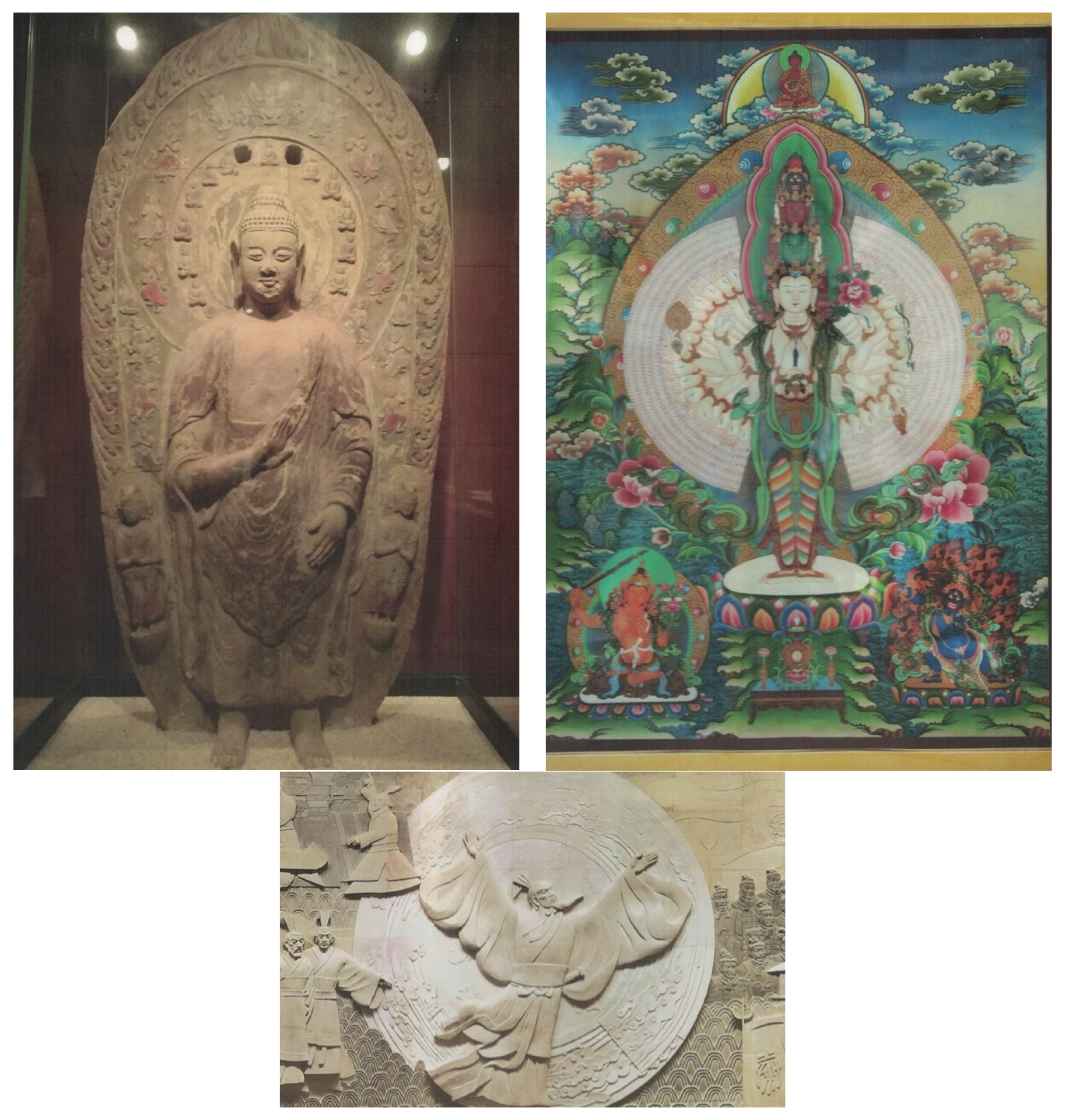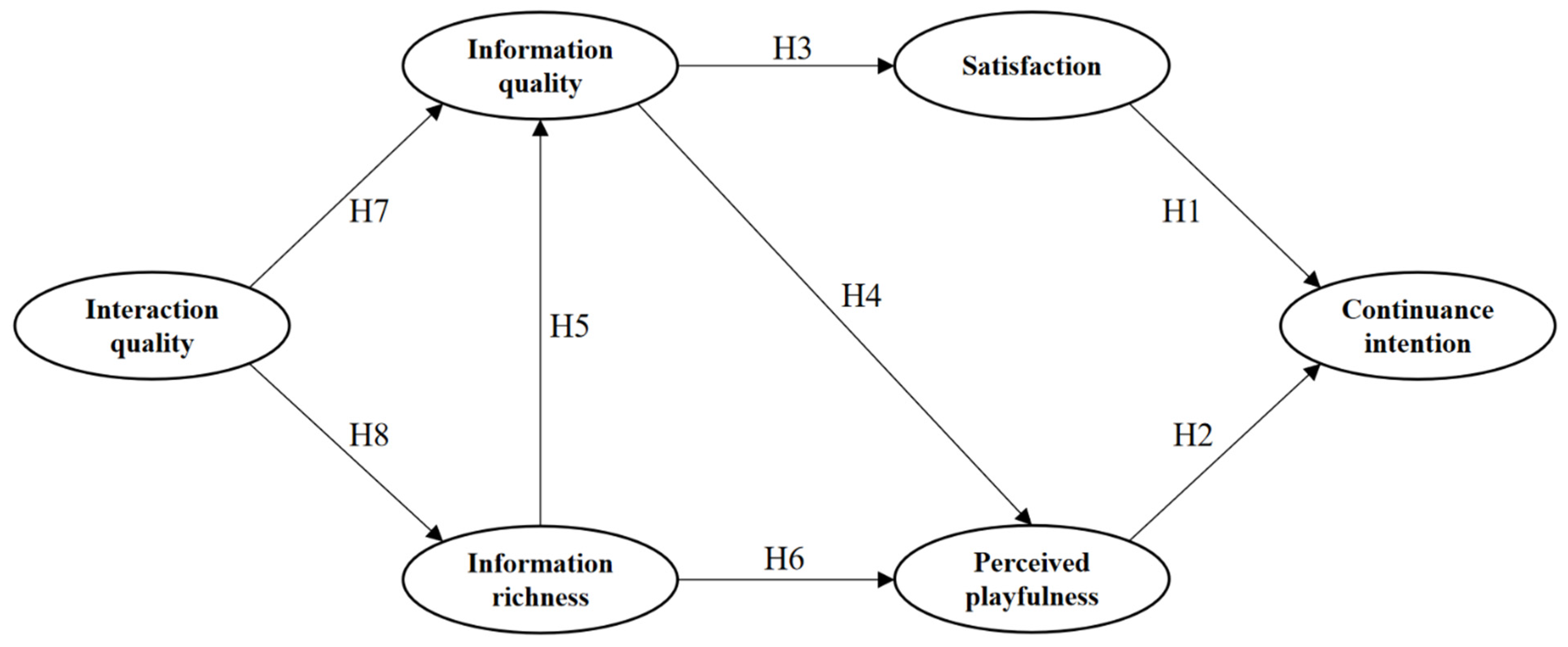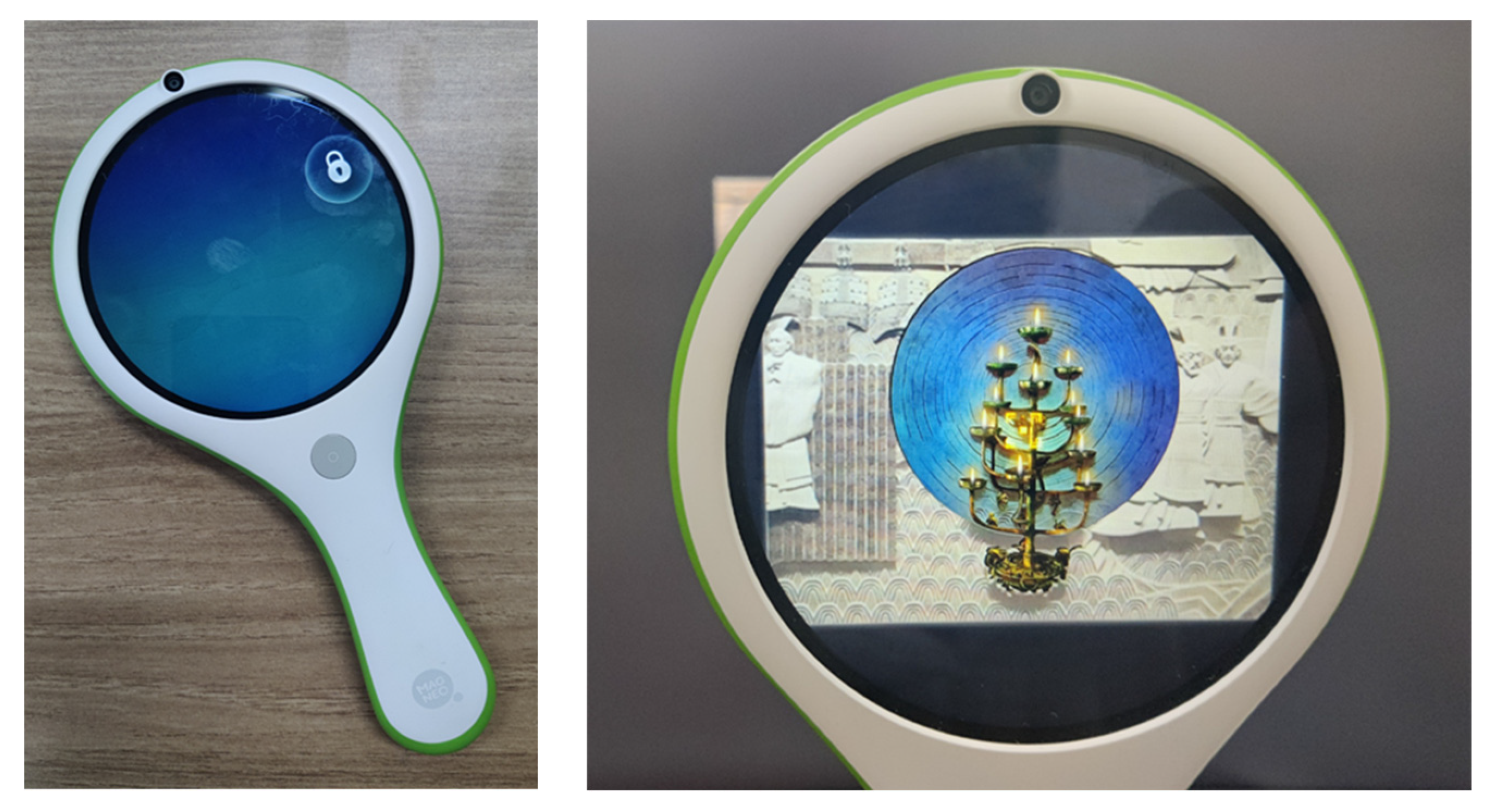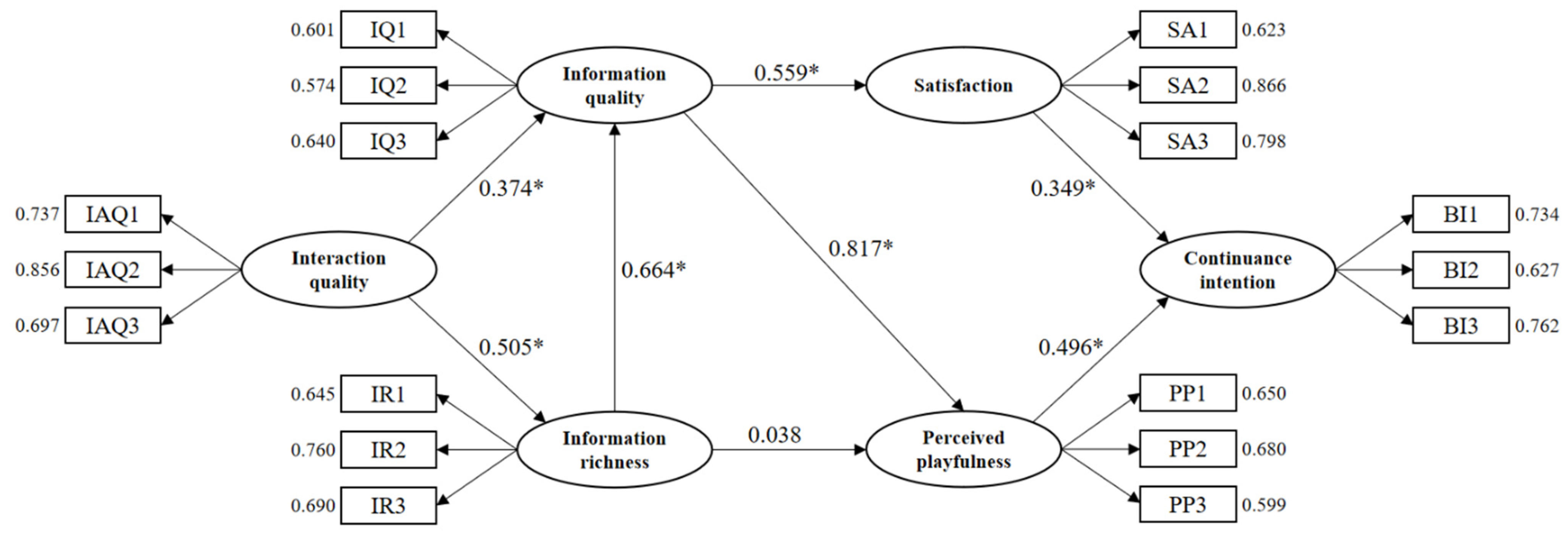1. Introduction
Information dissemination has changed owing to the development of information technology [
1], with digital media information gradually replacing traditional printed materials. Currently, there is a prominent trend where museums are changing visiting experiences from traditional guided tours to innovative visits supported by virtual technology and exhibiting their collections in the form of digital arts [
2,
3,
4]. Such virtual technologies are collectively known as Extended Reality (XR). Virtual reality (VR), augmented reality (AR), and mixed reality (MR) all belong to the XR technology category. XR technologies immerse users through visual, audio, and potentially olfactory and haptic touch cues [
5]. VR can create a virtual scene from the perspective of the first person, so that users can perceive interactive behavior in the virtual environment [
6]. However, AR can enable users to perceive virtual objects in a real environment [
7]. MR combines the advantages of VR to make users feel that the interactive experience of MR is more realistic [
5]. In other words, MR can create interactive visualization environments in which life-like 3D virtual design objects are displayed in the real world [
8].
VR and MR technologies provide 3D virtual simulations, which are better representations of construction information and built environments than traditional two-dimensional (2D) media [
9]. Users can interact with virtual objects and environments, enabling them to experience the built environment better and comprehend information [
9,
10]. VR has been successfully employed in various fields, including engineering, medicine, mental health, design, architecture, construction, education and training, arts, entertainment, business, communication, marketing, military, and travel [
5]. At present, the application of VR in the field of education is still in the exploratory stage, but more learning modes in museums or at other tourist attractions should be implemented in the future [
11]. On the other hand, AR is a new digital visualization technology that is not only recognized by scholars in education [
12,
13,
14], but also valued and used in tourism, cultural heritage, and experiencing museums [
15,
16,
17].
Recently, this technology has been considered an innovative guiding tool that can improve visitors’ experiences in museums [
18] because of its unique ability to superimpose virtual information on physical objects and real environments [
19]. In addition, it can bring real-world objects into virtual environments and vice versa [
20]. Furthermore, scholars have suggested that AR’s unique functions and visual interactivity can be an alternative to traditional text guides, even attracting new audiences [
21]. Hassan and Ramkissoon [
22] mentioned in their research that AR devices can attract different visitor groups. Meanwhile, the Franklin Institute in Philadelphia used AR to present soldiers and their weapons to visitors to the Terracotta Warriors exhibit. On the other hand, Ding [
23] designed and developed AR devices in his study that allowed for interactive entertainment between visitors and museums to improve visitors’ learning experiences. Ryffel et al. designed an AR system that attracts users to interact with it by manipulating the colors of paintings [
24].
It was found in studies ranging from cultural heritage to museums that virtual technology can help visitors interact with museum collections in the real environment. More importantly, the application of AR can help the public fully understand a large amount of information on famous collections without additional information provided by museums [
25,
26,
27]. It has been mentioned in two pieces of research that interactive behaviors combining experiential learning with innovative entertainment activities, other unusual narrative modes, and immersive experiences can improve the exhibition value of museums [
17,
28]. Other scholars have assessed the actual experiences of AR in museums from the perspective of user experience and behavior, including the fact that the adoption of AR devices in museums can improve visitors’ user experience [
27,
29], a study of users’ satisfaction with AR, their intention to recommend AR applications [
30,
31,
32], and a study of users’ satisfaction with AR devices and their behavioral intentions [
33,
34,
35].
Although scholars have explored how to better design interactive AR devices for museums [
36] to improve visitors’ experiences [
15], this study suggests that understanding the information of artifacts in museums through AR devices is significant for interactive experiences and the continuance intention of users. Therefore, by establishing and studying the hypothesis model, this study further verifies how the interaction quality between users and AR devices affects user satisfaction and perceived playfulness, especially users’ continuance intention, in terms of information quality (including dynamic visual effects and dynamic audio prompts) and information richness (including dynamic visual content).
Based on the above discussion, we carried out the following research process. Firstly, the research dimensions are established in consideration of the literature, and the research hypotheses are proposed in
Section 2. In
Section 3, the questionnaire is designed based on references. Then, the respondents were recruited to visit the museum exhibits with AR equipment, and data were collected. The data from the questionnaire in
Section 3 are analyzed in
Section 4, and the research hypotheses are verified in
Section 5. Finally,
Section 6 summarizes the research results and discussion, and puts forward future research and suggestions.
5. Discussion
The results indicate that satisfaction and perceived playfulness have significant and positive effects on continuance intention (H1 and H2 are supported), among which playfulness plays a greater role, indicating that visitors have a strong sense of freshness and curiosity toward the AR experience during museum visits, and that they are more likely to give a positive evaluation of the information provided by this system. The pleasure generated when using AR can effectively improve hedonic needs and further increase continuance intentions. In addition, the higher the users’ information satisfaction with AR, the more likely they are to believe that AR experiences can give them more benefits during museum visits, enhancing their willingness to continue using the technology. The establishment of the hypothesis of this study is consistent with scholars’ research that satisfaction affects the behavioral intention of visitors using AR [
33].
Second, information quality has positive effects on satisfaction and perceived playfulness (H3 and H4 are supported), among which perceived playfulness plays a greater role. Evidently, information quality reflects the value of users’ needs. For instance, scholars mention that the users appreciated more audio-visual augmentations than the ones based on the use of text only; the AR function can enrich visitors’ visual sense and emotional participation [
60]. Thus, high-level information quality (e.g., efficient, accurate, real, and available) output by AR can provide users with convenient use and promote knowledge understanding, thereby increasing experience satisfaction in museum visits. In addition, an audience using AR can have a richer and more interesting experience, dramatically enhancing their psychological expectations by admiring artifacts from diverse angles, breaking the one-way understanding of the text, and inspiring more intuitive historical imaginations. This result proves that information quality presented by high-tech means plays an important role in the enhancement of perceived playfulness.
Moreover, although information richness had positive effects on information quality (H5 was supported), its effect on perceived playfulness was not significant (H6 was not supported). Presenting artifacts through various channels of the AR technology may have resulted in transmitting information in a way that led to misunderstanding, making the visitors feel anxious, and creating a sense of loss of control when using AR. Consequently, the playfulness experience is affected.
Furthermore, interaction quality has positive effects on information quality and richness (H7 and H8 are supported). Given AR’s unique feature of AR in superimposing such graphics over real-world objects, visitors can interact with museum culture through AR devices [
41,
46]. These findings highlight the importance of generating stimulating and interactive museum experiences [
61]. The results show that AR technology can provide visitors with more opportunities for interaction or contact with cultural relics through diversified services during museum visits, thereby enhancing information richness. It can also help visitors obtain feedback that is highly related to their knowledge needs during use, which creates positive effects on their perception of information quality.
6. Conclusions and Future Research
It can be concluded from the results of this study that AR technology, like other technologies, has no internal value, carries information, and conveys developers’ intentions. The results on museum satisfaction indicate that the finding that visitors considered the interaction quality of AR to be closely related to information quality and satisfaction was based on the overall visiting experiences of visitors (interpretation of collections and interactive plots). Nevertheless, collections presented in the form of digital art by AR allow visitors to better understand and perceive artifact information. It also confirms the importance of visitors’ interactive experience provided by AR technology in museums, which helps visitors express their emotions about museum exhibits.
The extensive and in-depth research on the interaction quality of AR, the presentation of system information, and the relationship between user satisfaction and perceived playfulness provides important insights for museum staff, system developers, and managers, as follows: (1) The effective means to meet users’ psychological expectations in actual use is improving the interactive quality of AR, absorbing advanced information technology, continuously improving use functions, and designing a personalized experience environment and a technology system with better interaction; (2) The diversified presentation of artifacts should consider playfulness, as it is an influencing factor that cannot be ignored in improving users’ continuance intention. In actual construction, advanced technologies such as big data and artificial intelligence should be used reasonably, and interactive factors such as human–computer interaction and interpersonal interaction should be added to increase the playfulness of the system.
Although this study promotes the interactive experience of museum artifacts through visitors’ use of AR devices and analyzes the factors that influence the intention of continuous use, there are still some limitations that need to be considered in future studies. As for future research, first, it is necessary to start with immersive XR technology (VR/MR/AR), in addition to discussing the factors influencing visitors’ continuous use of AR devices. After understanding the situation of the target museum, it is necessary to consider the technology that can truly achieve an immersive visiting experience. For example, scholars have questioned whether MR substitutes or integrates cultural experience, preserving the authenticity and sense of a place [
28]. Second, considering the user’s convenience, is it more important to develop museum AR applications based on smartphones than hand-held AR devices or even wearable AR smart devices specially provided by museums? This satisfies the needs of visitors but raises a question, for example, what is the meaning of physical museums? Can digital technology really take its position? This question is worth considering. In addition, will the difference in AR equipment between planar and three-dimensional exhibits in museums affect visitors’ continuous use of AR equipment? Finally, comparative studies of different age groups are also of great importance, such as samples of children using AR devices to learn about museums, to allow developers and researchers to configure AR applications that are capable of effectively facilitating experiential learning for school children of all ages in museums.
















